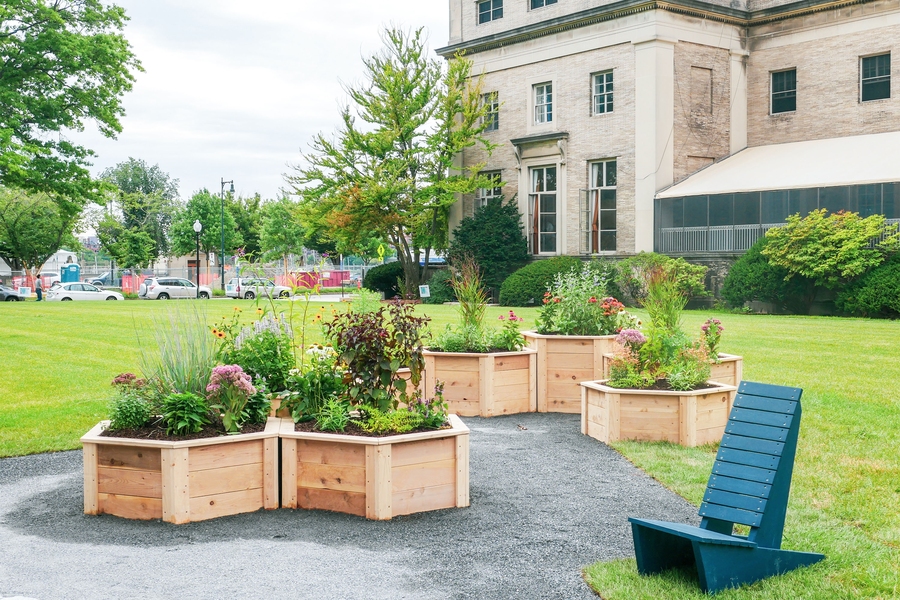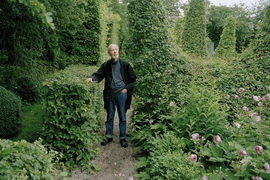Tucked beside Walker Memorial, just across from the Charles River, is a new space for the MIT community, native plants, and some important supporters — pollinators. The Hive Garden, a first-of-its-kind garden at MIT, recently opened on Saxon Lawn, creating a small and unique outdoor community space on campus.
Designed as a sustainability garden that will be in part maintained by students, the Hive Garden hosts nearly 40 unique varieties of plants to attract and support pollinators like bees, birds, butterflies, and moths — essential contributors to sustainable ecosystems and food systems. The garden also serves as a test bed for co-designing outdoor spaces to connect to, and learn from, nature in an urban setting.
Student-led sustainable idea
The idea behind the Hive originated in 2017, when members of the MIT Undergraduate Association Committee on Sustainability — known as UA Sustain — sought to leverage their collective power across campus to launch a large-scale project, says Soma Mitra-Behura '19, then co-chair of UA Sustain. “I decided to pitch the idea of a large-scale project to our whole committee. Out of this discussion came many ideas, including an industrial composter and solar panels on campus rooftops,” she explains.
Polling of the undergraduate population led to the winning idea of a collaboratively designed and maintained garden to both educate and engage students around sustainability efforts. As the group explored pathways for making their idea a reality, the garden became a cross-campus collaboration, and they began working closely with both the Office of Sustainability (MITOS) and MIT Grounds Services.
A unique collaboration
“Here [at MIT], you realize pretty quickly that you aren't going to make it if you try to figure everything out on your own,” says UA Sustain member Sam Nitz. At the outset, Environmental Solutions Initiatives Director Professor John E. Fernández advised UA Sustain on working with MIT leadership to pitch the idea and secure space for the garden.
“The Saxon Lawn was created last year to adapt to changes in this part of campus and provide more open space for the whole MIT community. We were supportive of the students’ idea of transforming part of the Saxon Lawn — as a newly created green space — into a test bed that brings sustainability to life for people making their way across campus and along Gray Way,” explains Associate Provost Krystyn Van Vliet. Van Vliet co-chairs the Committee for Space Renovation and Planning with Tony Sharon, and this team coordinated this plan and engagement of MIT Ground Services to enable the project. “The creative design process of students and staff, and thoughtful communication of how the garden is used and maintained, are critical to understanding how to foster unique ideas like this in the future.”
Once the space was secured, staff from MITOS began working closely with the students to help facilitate the design and execution process. Julie Newman, director of sustainability, explains that, “Bringing students together with operational staff to co-develop solutions is a central aspect of the methodology of the office. The vision for a community garden by the students warranted a multi-stakeholder partnership with representative students, staff, faculty, and administrators to design, implement, and now maintain.”
Students worked together to mock up visually exciting, community-centered designs for the garden. “The students’ early designs featured these intricate patterns of hexagonal planters that were like building blocks that you could configure in different ways within the space — some might grow plants, capture water, or generate solar energy,” explains Susy Jones, MITOS senior project manager who worked closely with the students.
To ensure the designs were suitable for the space and project budget, MITOS connected the students with MIT Ground Services — the team that keeps MIT’s outdoor space “accessible and beautiful.” Led by Norman Magnuson, manager of Ground Services, and in collaboration with landscape professionals, a design of several hexagonal planters spread diagonally across Saxon Lawn emerged. “I’ve worked with students on a few projects in the past, and it’s great to be around them — they have so much enthusiasm,” says Magnuson of the partnership.
The wooden planters used for the garden were made with sustainably-sourced wood and house dozens of native plants, offering diversity and support for various pollinators. In addition to a matching hexagonal picnic table for gathering, the space is outfitted with wooden chairs hand-crafted by architecture student and MITOS student design fellow Effie Jia.
The Hive Garden, which was completed in September, will be cared for both by students and Grounds Services, ensuring the garden and gathering space remains accessible to all — community members and pollinators alike. As the garden enters into a dormant period before blooming in the spring, the hope is that the collaborative process behind it can be replicated. “Our hope is that the Hive and the collaborative process behind it will serve as a model for future urban gardens for both MIT and beyond,” Newman says.











